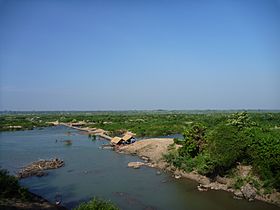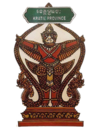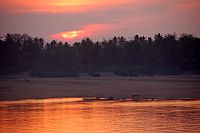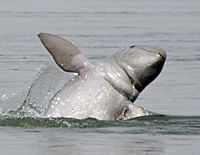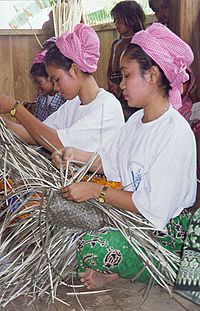Kratié province facts for kids
Quick facts for kids
Kratié
ក្រចេះ
Kracheh
Kraches |
||
|---|---|---|
| Kratié Province ខេត្តក្រចេះ |
||
|
||
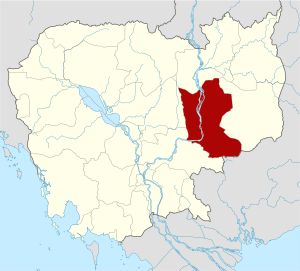
Map of Cambodia highlighting Kratié
|
||
| Country | ||
| Provincial status | 1907 | |
| Capital | Kratié | |
| Subdivisions | 1 municipality; 5 districts | |
| Area | ||
| • Total | 11,094 km2 (4,283 sq mi) | |
| Area rank | 7th | |
| Population
(2019)
|
||
| • Total | ||
| • Rank | 16th | |
| • Density | 34/km2 (90/sq mi) | |
| • Density rank | 19th | |
| Time zone | UTC+07:00 (ICT) | |
| Dialing code | +855 | |
| ISO 3166 code | KH-10 | |
Kratié (Khmer: ក្រចេះ, Krâchéh [krɑˈceh]), also spelled Kracheh or Kraches, is a province in the northeast of Cambodia. It shares borders with Stung Treng to the north, Mondulkiri to the east, and Kampong Thom and Kampong Cham to the west. To the south, it borders Tboung Khmum and the country of Vietnam.
The main city and capital of the province is Kratié, which is located within the Kratié Municipality.
Contents
History of Kratié Province
The land that is now Kratié was once part of the ancient Kingdom of Funan in the early first millennium. Later, in the 6th century, it became part of the Chenla empire. An old royal capital from the Chenla era, called Sampheak Borak, can be found in Sambo District.
Kratié is also home to Vihear Sasar Muayroy Pagoda, a religious building from the 16th century. This pagoda is linked to a famous Khmer legend about a crocodile and a monk. You can also find several temples from the 8th century, like Khvas Pi, Pram, and Koh Kring. These places have beautiful old statues, ancient halls, traditional Khmer houses, and buildings built in the French style. The area along the Mekong River near Kratié was once one of the most crowded parts of Cambodia before the famous Angkorian period.
In 1945, Lon Nol served as the governor of Kratié province. During the Vietnam and Cambodian Civil Wars, and later when Vietnam helped Cambodia against the Khmer Rouge, there was a lot of fighting in Kratié. The United States even bombed Kratié heavily between 1969 and 1970 as part of "Operation Menu." This bombing aimed to disrupt supply routes used by Vietnamese forces. Because of this, finding and removing unexploded ordnance (old bombs that didn't go off) and landmines has been a big project in Kratié since the mid-2000s.
On December 30, 1978, Vietnamese forces took control of Kratié as they fought against the Khmer Rouge.
Geography and Nature
The mighty Mekong River flows through Kratié province from north to south. About 140 kilometers (87 miles) of the river are within Kratié. This part of the river is a special home for Irrawaddy dolphins, many types of fish, and various birds. The water level of the Mekong River near Kratié town changes a lot throughout the year. During the rainy season, the river can rise by as much as 4 meters (13 feet), causing frequent floods.
Along the river, there are hundreds of islands that get covered by water during the rainy season. In 2007, the Cambodian government considered building a dam on the Mekong River close to Kratié town.
Kratié province also has many forests, the Phnom Pram Poan mountain range, and rubber plantations. The eastern part of Kratié is an important area for birds. Most of the province is covered by dense forests, often with deciduous trees that lose their leaves in the dry season.
You can still see large craters in the countryside from the "Operation Menu" bombings during the Vietnam War. Some of these craters are now filled with water. While some land in Kratié is used for farming, it's less than in other parts of Cambodia.
Kratié is well-known for its beautiful riverside views, green villages, and rice fields. It's also famous for its rare river dolphins. The fishing in Kratié is mainly for people to catch food for themselves, not for large commercial fishing.
Government and Economy
Sar Chamrong is the current governor of Kratié province. Hoeu Sidem serves as the deputy governor. In local elections held in 2007, most of the seats in the commune councils (local government bodies) were won by members of the Cambodian People's Party. About 17.4% of the commune council members are women.
Most people in Kratié make a living as farmers or fishers. About 78% of the residents work in agriculture. Rice farming is a very important part of the province's economy.
Some gold mining also takes place in Kratié. However, much of the soil in Kratié is not very fertile. Because of this, the province mainly grows long-term crops like rubber trees. Kratié has the potential to become a great place for ecotourism, which is tourism focused on visiting natural areas.
The roads in Kratié are not very well developed. In 1998, the average family owned about half a hectare (1.2 acres) of farmland, and 37% of families did not own any land.
Community Life and Development
Kratié province faces some health challenges. For example, schistosomiasis, a disease caused by parasites, is a problem here. The number of people getting malaria and dengue fever increased a lot in the mid-2000s, partly due to changes in the climate. Malaria is very common in Kratié's forests. Sadly, the number of babies and young children who do not survive is higher in Kratié than the national average.
Even though Kratié is one of Cambodia's poorer provinces, it was ranked fifth in the country for high-school exam pass rates in 2015. However, schools often struggle to attract teachers to this mostly rural area. New teachers from Phnom Penh, the capital city, are sometimes sent to Kratié. They might see it as a chance to pass a teaching exam that is less strict in remote areas. But these teachers often don't stay for more than a year or two because the pay is low. This means local officials have to manage without enough teachers, and students sometimes have to learn on their own.
People and Culture
Kratié province has a significant number of Vietnamese people living there. It is also home to seven different indigenous groups: Bunong, Kouy, Mil, Khonh, Kraol, Steang, and Thamoun. About 8% of Kratié's population belongs to these indigenous groups, making it one of four provinces with many indigenous people.
Around 70% of the province's residents live along the Mekong River. The areas further away from the river are not as populated. Overall, about 70% of the population lives in rural areas.
Religion
Religion in Kratié province (2019 census) Buddhism (93.1%) Islam (6.6%) Christianity (0.2%) Animism and Other religions (0.1%)
The main religion in Cambodia is Theravada Buddhism. In Kratié province, more than 93.1% of the people are Buddhists. About 6.6% of the population, mainly Chams, follow Islam. A smaller number, 0.2%, follow Christianity. About 0.1% of the people follow Animism or other traditional religions.
Areas and Districts
Kratié province is divided into 5 districts (called srok) and 1 municipality (called krong). These are further split into 47 communes (called khum).
| ISO code | Name | Khmer | Population |
|---|---|---|---|
| 10-01 | Chhloung | ឆ្លូង | 50,407 |
| 10-02 | Kratié | ក្រចេះ | 79,123 |
| 10-03 | Preaek Prasab | ព្រែកប្រសព្វ | 56,757 |
| 10-04 | Sambour | សំបូរ | 41,732 |
| 10-05 | Snuol | ស្នួល | 61603 |
| 10-06 | Chetr Borei | ចិត្របុរី |
One of the districts, Preaek Prasab, is located west of the Mekong River.
Images for kids
See also
 In Spanish: Provincia de Kratié para niños
In Spanish: Provincia de Kratié para niños




